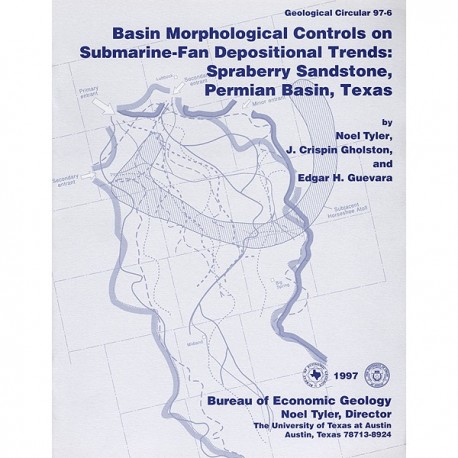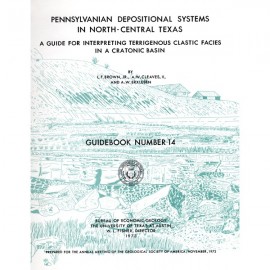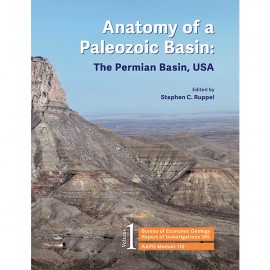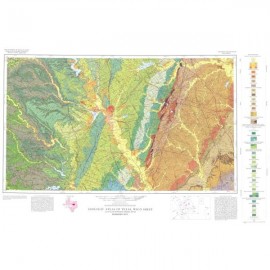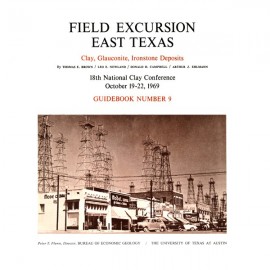Geological Circulars
-
Books & Reports
- Reports of Investigations
- Guidebooks
- Udden Series
- Geological Circulars
- Down To Earth
- Atlases of Major Oil and Gas Reservoirs
- Texas Memorial Museum Publications
- Environmental Geologic Atlas of the Texas Coastal Zone
- Mineral Resource Circulars
- Other Reports
- Seminars and Workshops
- Handbooks
- Submerged Lands of Texas
- Symposia
- Annual Reports
- Open File Reports
-
Maps & Cross Sections
- Thematic Maps
- Miscellaneous Maps, Charts & Sections
- Geologic Atlas of Texas
- STATEMAP Project Maps
- Geologic Quadrangle Maps
- Cross Sections
- Highway Geology Map
- Energy and Mineral Resource Maps
- Shoreline Change and Other Posters
- Wilcox Group, East Texas, Geological / Hydrological Folios
- Bouguer Gravity Atlas of Texas
- River Basin Regional Studies
- Featured Maps
- Posters
- Teachers & the Public
-
Geological Society Publications
- Gulf Coast Association of Geological Societies
- Alabama Geological Society
- Austin Geological Society
- Corpus Christi Geological Society
- Houston Geological Society
- Lafayette Geological Society
- Mississippi Geological Society
- New Orleans Geological Society
- South Texas Geological Society
- GCS SEPM Publications
- Historic BEG & UT Series
Basin Morphological Controls on Submarine-Fan Depositional Trends: Spraberry Sandstone, Permian Basin, Texas
GC9706
For a downloadable, digital version: GC9706D.
GC9706. Basin Morphological Controls on Submarine-Fan Depositional Trends: Spraberry Sandstone, Permian Basin, Texas, by Noel Tyler, J. C. Gholston, and E. H. Guevara. Assisted by John Farrelly and W. B. Wethington. 43 p., 30 figs., 1997. ISSN 0082-3309: Print.
To purchase this publication as a downloadable PDF, please order GC9706D.
ABSTRACT
The Leonardian Spraberry Formation is a major oil-producing formation of the Permian Basin, accounting for more than 700 million barrels of oil produced from heterogeneous submarine-fan reservoirs. Extensive exploration and development of the Spraberry and deeper reservoirs provide the opportunity to establish the sedimentary evolution of a fan cone fed only by relatively small rivers and windblown sediment in a tectonically inactive setting. Because the Spraberry is not exposed, the study utilized a rich subsurface data base of more than 1,200 well logs developed in the pursuit of the 10 billion barrels of oil discovered in the fan cone. Entrapment of this oil is almost entirely stratigraphic, most of the resource being captured in mid-fan to distal fan sediments in the distal Midland Basin more than 100 mi basinward of the shelf edge. The analysis of controls on depositional trends in the Spraberry had an immediate goal of providing a framework for continued Spraberry exploration. Taken in broader context, however, the Spraberry provides a superb analog for fine-grained, mud-rich offshore fan systems, which are a high-priority, global target for exploration and development. Patterns of sedimentation were strongly influenced by the paleobathymetry of the north-south- elongate Midland Basin. Approximately 200 mi long and a maximum of 80 mi wide, this long but narrow basin was fringed by prograding carbonate shelves. Siliciclastic sediment entered the basin through multiple canyons incised mostly across its north rim. Focus of sediment influx shifted temporally, and sediment transport through canyons was intermittent. Temporarily abandoned canyons were reoccupied during later depositional cycles. The basin consisted of a smaller, proximal subbasin landward of the subjacent Horseshoe Atoll, beyond which, down slope, was a more extensive basin composing the distal basin floor. Differential compaction of pre-Spraberry sediment overlying the peak-and-saddle morphology of the Horseshoe Atoll profoundly influenced Spraberry sedimentation patterns. Bathymetrically low saddles between atoll mounds became conduits for sediment transport into the deeper basin. Proximal submarine-fan sediment was initially ponded landward of the atoll then cascaded into the deeper and more distal basin plain. Flanking basin slopes laterally restricted prograding fan lobes. Predominant sediment influx to the proximal subbasin was from the northwest. As sediments spilled across the subjacent atoll, fan deposits graded basinward from proximal fan to mid-fan, and transport was redirected to the southwest by a prominent shelf-slope promontory (Glasscock narrows) along the eastern margin of the subbasin. Distal fan deposits lie south of the promontory. Almost all of the production from the Spraberry is from mid-fan to distal fan deposits basinward of the Horseshoe Atoll.
Keywords: Permian Basin, Spraberry, submarine-fan systems, Texas
CONTENTS
Abstract
Introduction
Setting of the Spraberry submarine-fan system
Approach
Basin bathymetry and stratigraphy of the Spraberry fan cone
Depositional patterns of major sandstone units in the Spraberry fan cone
The Jo-Mill fan-lower Spraberry genetic unit 2
Thickness trends
Net-sandstone trends
Percent-sandstone trends
Facies composition
Interpretation
The Jo-Mill fan-lower Spraberry genetic unit 1
Thickness trends
Net-sandstone trends
Percent-sandstone trends
Interpretation
Paleobathymetric control on proximal fan depositional patterns: Jo-Mill field area
The Driver fan-upper Spraberry genetic unit 5
Thickness trends
Net-sandstone trends
Percent-sandstone trends
Facies composition
Interpretation
Floyd fan-upper Spraberry genetic unit 1
Thickness trends
Net-sandstone trends.
Percent-sandstone trends
Facies composition
Interpretation
Depositional pathways of the Spraberry fan cone
Hydrocarbon distribution and relation to basin architecture
Potential for additional small-field discovery
Conclusions
Acknowledgments
References
Figures
1. Generalized structure of the Permian Basin and location of selected Spraberry/Dean oil fields in the Midland Basin
2. Paleozoic stratigraphy of the Midland Basin
3. Well log data base and cross-section grid
4. Type log of the Spraberry Formation in the central Spraberry Trend showing several scales of division of the formation and principal vertical trends
5. Isometric block diagram showing the structure of the top of the Spraberry Formation in the Midland Basin
6. Spraberry dip section 10-10' along the east flank of the Midland Basin showing the basinward thinning of sandstone-rich lower and upper Spraberry units
7. Spraberry strike section 1-1' in the proximal part of the Midland Basin
8. Spraberry strike section 5-5' in the distal parts of the Midland Basin
9. lsopach map of lower Spraberry unit 2L
10. Net-sandstone map of lower Spraberry unit 2L
11. lsopach map of the Horseshoe Atoll and location of major Spraberry and Dean submarine-fan fields in paleobathymetric lows between subjacent carbonate buildups
12. Percent-sandstone map of lower Spraberry unit 2L
13. Simplified log facies map of lower Spraberry unit 2L
14. lsopach map of lower Spraberry unit 1L
15. Net-sandstone map of lower Spraberry unit 1L
16. Percent-sandstone map of lower Spraberry unit 1L
17. lsopach maps of total sandstone thickness of reservoir units 2L and 1L in Jo-Mill field
18. Percent-sandstone values of reservoir units 2L and 1L in Jo-Mill field
19. lsopach map of upper Spraberry unit 5U
20. Net-sandstone map of upper Spraberry unit 5U.
21. Percent-sandstone map of upper Spraberry unit 5U
22. Simplified log facies map of upper Spraberry unit 5U
23. Net-sandstone map of upper Spraberry unit 1U
24. Percent-sandstone map of upper Spraberry unit 1U
25. Simplified log facies map of upper Spraberry unit 1U
26. Depositional axes of the Spraberry fan cone
27. Aggregate sediment transport in parts of the Spraberry fan cone
28. Temporal and spatial variation in the Spraberry fan-cone systems tract
29. Spraberry production areas in the Midland Basin
30. Potential small-field stratigraphic traps in the basin and basin margin
Citation
Tyler, Noel, Gholston, J. C., and Guevara, E. H., 1997, Basin Morphological Controls on Submarine-Fan Depositional Trends: Spraberry Sandstone, Permian Basin, Texas: The University of Texas at Austin, Bureau of Economic Geology, Geological Circular 97-6, 43 p.
